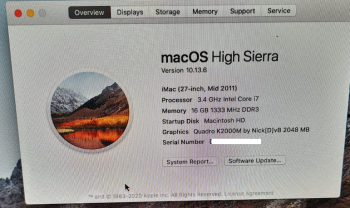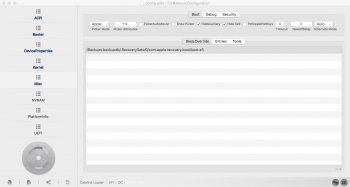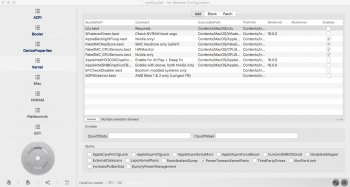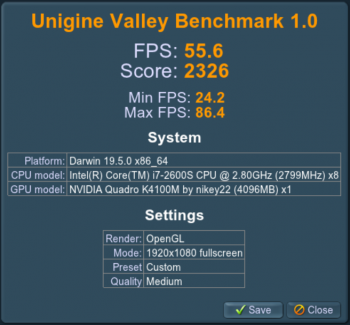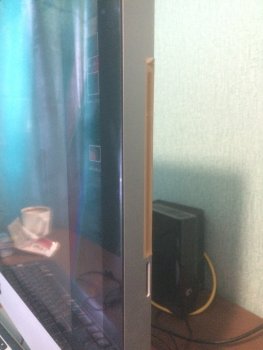Preamble (Last Updated 09/23/2020)
You have probably found this thread because your iMac 2009-2011 is having problems caused by the graphics card. It is well known that these graphic cards are problematic/defective. You will find websites that encourage "baking" the card. Without getting into the technicalities, it will work but this does not repair the graphics card. In fact, it only delays the problem. We have great news for you! You can install another graphics card that does not require much more effort. In addition, this will allow you to install more recent versions of MacOS. This thread has over 300 pages of useful information BUT the good news is all of that information has been summarized in this first post. It is HIGHLY recommended that you read through this post before asking questions. Then, reread the information. You will appreciate that the more experienced users cannot spoon-feed all new users. This distracts them from working on the files and tools that make all of this possible. Enjoy!
Choosing the Right Card
This is the most important part of this process. The following information will help guide you in choosing your card. We have included the issues (loss of brightness control, loss of boot screen, loss of target display mode, etc.) to overcome when installing a non-stock card into a 2009-2011 iMac. When choosing your replacement graphics card, you must take under consideration: your budget, your comfort level with doing modifications, your ability to live with unresolved issues, your computing needs, etc. Unfortunately, this thread cannot help you source cards as there are two many variables involved. Read through this information carefully in order to choose the best card for your needs.
Important Notes Before You Begin
- The modified (video) BIOS version made by @Nick [D]vB, @nikey22 and @internetzel require an Intel i3 CPU or better. There is currently no way to make the features of these VBIOS working on Core 2 Duo systems (late 2009).
- Please do not harass the BIOS developers to go faster, release a particular BIOS, etc. Please do not clog up the thread with useless posts asking if your specific card will get a new BIOS. Ask not what this thread can do for you, but what you can do for this thread. It takes several months of reverse engineering and testing before getting a new BIOS working. It took only six years for the first really working card here on this thread! If you would like to use a different card, consider yourself in unknown territory. Of course, let us know if it works! Chances are that Kepler based cards will run using the right (most likely Dell) BIOS but will exhibit the seven problems listed below.
- There are two type and sizes of cards: Smaller MXM-A cards and bigger MXM-B cards running stable only in the 27" models. While all cards will function in a 21.5" model, they are unstable due to their high power draw. @highvoltage12v tested a 770M here and had frequent Kernel Panics in macOS and BSoD's in Windows. Do not try it!
- For all Nvidia MXM B cards and the WX7100 you need the MXM-B heat sink from the 27" mid 2011 model. This is the only sink with three heat pipes capable to get the generated heat by using 75W out of the system unter load.
- You may face all kind of hardware problems after assembling your iMac again. There is an incomplete list of common problems including the links to the original Apple iMac Technician Guides to trouble shoot such problems. Please understand that we cannot remotely repair or identify broken hardware. And there is no proof possible that hardware is broken. Do not ask for one. You may likely buy a dead used card. Check it before! This is not the "repair my iMac help desk thread".
- The perf column reflects the OpenGL performance relatively to the original HD6790M (Unigine Valley)
Table of Working Graphics Cards (A PDF document of this information is available at the end of this post.)
| Card | BIOS link | Boot Screen | Brightness Control | 21.5/27/MXM | Heat Sink Mod | perf |
|---|
| Quadro K610M + | ROM | yes (natively) | yes (OpenCore) | yes/yes/A | no | 35% |
| Quadro K1100M + | ROM | yes (natively) | yes (OpenCore) | yes/yes/A | no | 65% |
| Quadro K2100M + | ROM | yes (natively) | yes (OpenCore) | yes/yes/A | no | 100% |
| Quadro K1000M * | ROM | yes (natively) | no | yes/yes/A | no | 35% |
| Quadro K2000M * | ROM | yes (natively) | no | yes/yes/A | no | 65% |
| Quadro K3000M ** | ROM | no | no | no/yes/B | yes, 2 pipe | ? |
| Quadro K3100M ++ | ROM | yes (natively) | yes (natively) | no/yes/B | yes, 3 pipe | 130% |
| Quadro K4100M ++ | ROM | yes (natively) | yes (natively) | no/yes/B | yes, 3 pipe | 200% |
| Quadro K5000M ++ | ROM | yes (natively) | yes (natively) | no/yes/B | yes, 3 pipe | ? |
| Quadro K5100M ++ | ROM | yes (natively) | yes (natively) | no/yes/B | yes, 3 pipe | 200% |
| GTX 765M * | ROM | yes (natively) | no | no/yes/B | yes, 3 pipe | 110% |
| GTX 770M * | ROM | yes (natively) | no | no/yes/B | yes, 3 pipe | 160% |
| GTX 780M ++ | ROM | yes (natively) | yes (natively) | no/yes/B | yes, 3 pipe | 200% |
| GTX 880M ++ | ROM | yes (natively) | yes (natively) | no/yes/B | yes, 3 pipe | 150% |
| GTX 860M ++ | ROM | yes (natively) | yes (natively) | no/yes/B | yes, 3 pipe | 130% |
| GTX 870M ++ | ROM | yes (natively) | yes (natively) | no/yes/B | yes, 3 pipe | ? |
| AMD WX4130 +++ | ROM | yes (OpenCore) | yes (natively) | yes/yes/A | no | 130% |
| AMD WX4150 +++ | ROM | yes (OpenCore) | yes (natively) | yes/yes/A | no | 130% |
| AMD WX4170 +++ | ROM | yes (OpenCore) | yes (natively) | no/yes/B | yes, 2 pipe | 130% |
| AMD WX7100 +++ | ROM | yes (OpenCore) | yes (natively) | no/yes/B | yes, 3 pipe | 230% |
* BIOS by
@Nick [D]vB that currently enable boot screens on your iMac, better performance, and BootCamp support.
** Only Kepler based cards work in iMacs. The K3000M has been
used with High Sierra by
@Roman78. Using OpenCore all these cards can have a limited boot screen functionality, now.
+ BIOS by
@Nick [D]vB, and the Wizzard
@nikey22 that currently enable boot screens on your iMac. Using OpenCore with these cards offers right now
native brightness control, target display mode, UEFI Windows 10, and more! To enable backlight in UEFI Windows 10, see
this post by
@internetzel.
++ BIOS by Wizzard
@nikey22, and
@stephle for the K5000M that currently enable boot screens and native brightness control on your iMac. To enable brightness controls in UEFI Windows 10, see
this post and this more recent
post. Only the audio support with UEFI Windows 10 would make OpenCore necessary.
+++ These AMD cards are much more modern, but are difficult to source.
Check the online offers carefully (the differences are explained below). With custom BIOS and OpenCore, these are very compatible and offer
native brightness control, boot screens, UEFI Windows 10, and much more modern capabilities and future-proofing than the NVIDIA cards. They also allow for Sidecar, 4K H.264, and huge 4K HEVC decode/encode gains in production. There are still some problems to solve. Using the GOP BIOS (links within the table above) you will get native brightness and a boot selection only with OpenCore. Using the
EG BIOS version you will get a native Apple boot picker with an iMac firmware modification, but no brightness control. Both solutions have their advantages.
- AMD WX7100 (recognized as Radeon RX 580 in macOS)
It is important to identify the card. This card has been unpredictable. @Nick [D]vB has obviously a working card with number 109-C95847-00C_02. @Pascal Baillargeau has a card working with number 109-C95847-00D_02. However, other users have not been successful with the same exact models. For example, @Vego17 recently got the same card as @Nick [D]vB. But his card did not work in his iMac 2011 while it does run normally in a Dell Precision 7710 laptop.
- AMD WX4170 (recognized as Radeon RX 560 in macOS)
Some come with a blank EEPROM and are missing a resistor. Working models with EEPROM are scarce. User @jborko did a write up HERE on his experience installing a WX4170. You can use the 4GB version of the latest WX4150 rom too (refer to the table at the beginning).
- AMD WX4130/WX4150 (recognized as Radeon RX 460 or RX560 depending on used BIOS in macOS) - currently 09/10 Only
This card needs to have an EEPROM chip on board too. There are multiple versions of this card - only the "Dell" branded versions currently work. These WX 4130/4150 are not detected in every case by the 2011 iMacs for unknown reason, and therefore are currently not fully compatible. Even worse, some models are not detected in any iMac model from late 2009 to mid 2011. A few Dell versions will be recognized and run in 2011 models. There is currently no rule available to figure out in advance which model will run. Same situations as with the WX7100.
Issues with an Unsupported PC MXM Card Without a Custom vBIOS (the seven problems):
- The loss of EFI boot screen;
- The loss of backlight control;
- You can only connect one external monitor to 27" iMacs;
- The loss of Target Disk Mode;
- The loss of Target Display Mode (TDM);
- The loss of running the built-in Apple Hardware Test (AHT);
- The loss of temperature sensors on the new GPU.
1. Boot Screens are now available on all listed cards using custom VBIOS and/or OpenCore
You may use the OpenCore booter to add a boot screen feature to every card - even the Nvidia and AMD cards not listed here or known to have no BIOS support to show the original apple boot picker. There is a small delay between the chime (POST) and the initialization of the actual boot screen on the current NVIDIA modded BIOS. Most of the time (such as a quick reboot in macOS) the system boots too quickly for the EFI portion of the BIOS to initialize, making it appear that you may not have a "boot screen." All is working as intended if you can hold the "Option" key at startup and get a boot picker.
2. Native Brightness control is available for cards marked with + or ++ using a combination of custom BIOS and OpenCore.
For other cards, brightness control may be added in the future. Be aware that without brightness control, the iMac display runs at full brightness by default. For higher powered cards and 27" models, this can generate a lot of heat.
If you would like to "dim" your display using color dimming, many have used the app
Brightness Slider, which is available on the App Store for free.
You can also use
this app, which works better than most apps in the App Store, because it will dim the colors on the whole screen and it will display the built-in OSD, just like native brightness control.
Additionally, hardware level modifications using a DyingLight module or a Raspberry Pi have been used for brightness control.
This software written by
@passatgt can be run on a Pi for backlight control.
Nvidia cards marked with ++ with native brightness control may notice their displays are not hitting maximum brightness control Potential. A kext modified by
@highvoltage12v can be found
here to fix this issue.
Last, but not least: User
@Lottosmp came up with a
solution based on the former engineering.
3. Despite having
2 miniDisplayPort outputs, the 27" 2011 iMac will only output to one external display. There is currently no fix or workaround for this.
4. Target Disk Mode is available on all cards marked with a + or ++!
5. Target Display Mode (TDM) is available on for cards marked with + when using both custom BIOS and OpenCore. Target Display Mode is *only* stable under High Sierra and should not be used in later OS's.
6. Apple Hardware Test (
AHT): There is currently no fix for running the internal service diagnostics. You may search the net for the ASD (Apple Service Diagnostic) package instead. For each system there is a different package. Download and install the package onto a SD card or a DVD, which will give you full functionality. A working download link may be hard to find. It is not open source.
7. GPU Temperature Monitoring is available on cards marked with a + or ++when using both custom VBIOS and OpenCore. A modified version of FakeSMC and GPUSensors is included with the OpenCore bundle to allow monitoring of GPU temps.
But you still have to use some third party tool to control the fans. The GPU die temperature is not available and (probably for that reason) the Apple SMC still not running properly.
~~~~~~~~~~~~~~~~~~~~~~~~~~~~
Q: Is this easy? I need a quick fix for my iMac!
A: Not necessarily. This "fix" is more of a "mod" to revive our iMacs. Depending on your scenario, it will require a full iMac disassembly, knowledge of BIOS flashing, dremel tools, heatsink modification, careful handling of logic board components, system administration at a higher level and some Unix or terminal command line awareness. With the used/grey market for many of these cards, other issues may pop up as well.
Please inform yourself before undertaking this process.
Q: My system boots up, but I don't have internal display, any display, or my GPU is not recognized correctly. What do I do?
A: Your MXM card is likely running an incompatible BIOS and will need to be flashed with the correct one. This can be done from within Windows or Linux using NVFlash, or with a CH341a programmer.
Q: Flash VBIOS? How do I do that?
A: BIOS can be flashed in one of two ways: Either directly with a CH341a clip programmer or with the "NVFLASH" software in Windows or Linux.
THIS POST helps describe the flashing process. Others have found
THIS POST useful. User
@xanderon created a pre-made USB that can flash Nvidia cards in the iMac with Linux over SSH. Many have found this the easiest method. There is an
add-on to flash AMD cards using this method, too. Additionally, user
@jowaju created
a simple Installer package that can be run on macOS Sierra (10.12) and higher that creates a 15GB Windows 7 Bootcamp partition with all the needed tools. Do a
PRAM reset after flashing if you cannot boot into a known to work MacOS version!
Q: OK, so I need to use the NVIDIA web drivers, right?
A: No - all cards outlined in this guide use the included NVIDIA drivers in macOS. No additional GPU drivers are needed.
Q: Why aren’t you using Maxwell or Pascal cards in the iMac?
A: A lot of people here have tested Maxwell cards with their 2011 iMacs, and have had various issues from no internal display, no backlight on internal display and the card not hitting boost. Additionally, macOS Mojave (10.14) deprecated support for the NVIDIA Web Drivers which allowed the use of Maxwell and Pascal cards. For now, Kepler GPUs and the experimental Radeon cards seem to be our path forward.
Q: Can I use a 4K display with these cards? The original card doesn't support 4K.
A: Yes! So far, the K1100M & GTX 770M have been tested firsthand and successfully provide 4K@60Hz output via mDP to DP adapter on a 4K display. Others should work just as well.
Q: What paste is recommended to cover the VRAM/Components on the MXM card like Apple’s design?
A: For the GPU Die any thermal Paste like Thermal Grizzly’s Kryonaut paste is good for the Die. For onboard components, many recommend using
K5 Pro Viscous paste instead of thermal pads, due to the unevenness of the heatsink, it’s also similar to Apple’s original Design. You can get it from the
Bay or from the
Book Store, too.
Q: What kind of
performance can I expect after installing one of these cards?
A: We are still aggregating GPU benchmarks. You can help by running
UNIGINE VALLEY on your iMac at 1080P MEDIUM and
submitting the
OpenGL results. You can also view the
results! Since the new GPU ofter native
metal hardware support it is worth to measure this running the free
GeekBench5 (metal),
uploading, or reading the
results.
Q: Are there any internal modifications needed for an MXM-A swap?
A: For an MXM-A swap (the shorter/less power draw cards) there are no modifications that are needed for the heatsink on both the 21.5" and 27" model iMacs. The X-clamp still needs be removed from the back of the card and have the screw posts drilled or
tapped out in order to fit the heatsink's screws. Separate the X-Clamp using a hair dryer before drilling or tapping - it is just glued to the board. Skipping this step can fry or damage your card. If you've cleaned your heatsink, be sure to re-apply thermal pads around the GPU VRAM to prevent contact with the bare metal of the heatsink. Use electrical tape to isolate card components from the sink! Watch closely after installing the card. Take a look at the attached pictures of this post!
Q: Are there any additional internal modifications needed for an MXM-B swap?
A: The MXM-B cards only work on the 27" models due to power restrictions. There is one
additional mod needed to make the MXM-B card fit. First you must grind down your heatsink in the area where one or two large coils sit, this way the card will sit flush with the heatsink. You must prepare the the X-clamp in the same way as described with MXM-A cards above. Take a look at the attached pictures of this post!
Some cards may work with the bigger MXM-B heat sinks with 2 copper pipes from the 2009 and 2010 models due to limited power draw. The WX4170 with a TPD of 50W
is, the
K3000M and K3100M may be such a candidate. The HD 5850M is listed with
40W-60W power draw.
If you have a
2 pipe heatsink that came with the lower end GPUs on these iMacs and want to use an MXM-B Card, you'll have to buy a
3 pipe heatsink to cool cards properly. You can get these on eBay.
Q: After GPU change my system does not boot at all, what is wrong?
A: Most likely the installation of card on the heat sink caused a short, or the card is simply faulty, or the card has not been reseated in the slot properly, check all this out first. Any hardware issue has to be solved by yourself!
Q:
I want to help and experiment, what can I do?
A: First, read the full thread. Staying on top of the progress here is key! Currently, backlight mods in BIOS are being researched as well as boot screens and alternate video card solutions.
Installing OpenCore and macOS on your upgraded iMac
With the addition of our newer GPU, Metal is natively supported allowing for installation of macOS Mojave and Catalina with full graphics acceleration.
But you need to make sure in advance you have already installed the lastest Apple firmware for your iMac. This can be done by installing High Sierra and all published Apple Update first before you can use the Catalina Loader or Mojave or Catalina.
OpenCore / Catalina Loader:
Before starting this use the
RomTool and backup your iMac EFI firmware and save it to an external storage device.
When we use the phrase Catalina Loader and OpenCore at the same time it is because the Catalina Loader is a piece of software based on OpenCore. To use this software to get brightness control or a boot picker just download the
latest image based on OC version 0.6.0, copy it to an USB memory or SD card, boot from it and that it is! You will find a short documentation attached to the post. There is no more need for a manual configuration. You just need to rename a file.
If you want to know what happens behind the curtain please read
the original OpenCore post for more info.
@herrdude provided an additional
guide, another longer one by
@Ausdauersportler and others named
"Using Catalina Loader on an iMac" focussing on the special needs of 2011 models and special settings for AMD cards. All guides are worth reading
before starting the installation. And you may take a look at this
thread, the MacPro users basically explored the same things.
Using older macOS versions
Currently we have no recent reports of users having a Kepler based Nvidia card installed with an older macOS versions than Sierra. According to this
list the Nvidia drivers are part of macOS since 10.8.3. You might check this out on your own.
Installing macOS Sierra
Supported MacOS version can be installed using the original Apple installer.
Installing macOS High Sierra
Supported MacOS version can be installed using the original Apple installer.
Installing macOS Mojave
Since you will have a Mojave compatible GPU, you could run the newest macOS without any serious issues. The recommended method is to have High Sierra as your primary OS and install Mojave alongside on a separate partition. So if anything goes wrong, you can still boot back into High Sierra to fix issues. You could preinstall Mojave before changing your GPU. Use
dosdude1's Mojave patcher to do the install.
Important: While running the Post Install tool, make sure you deselect the Legacy Video Card patch option (since you will using a new, compatible metal graphics card).
Mojave 10.14.6 (2020-003) shows the black screen issue solved by this
patched extension.
Installing macOS Catalina
The process for Catalina is similar to Mojave as mentioned above. Similarly to Mojave, you could preinstall Mojave before changing your GPU. Use
dosdude1's Catalina patcher to do the install:
Important: Post-install patching has changed since Mojave. Patching is now automated if your SMBIOS is detected to be an unsupported machine. Currently, only the 2011 iMacs have the "Legacy Video Card Patch" disabled by default. You will avoid this patch (since you will use a new, compatible metal graphics card) and will need to modify a plist file if you are using a 2009/2010 iMac with a Metal compatible video card.
Alternative:
While building the patcher, you can go to the "Options" menu and de-select "Auto-Apply Post-Install Patches" to avoid this.
Important: While running the Post Install tool, make sure you deselect the Legacy Video Card patch option (since you will using a new, compatible metal graphics card).
See next section to manually fix this issue if you have accidentally install this patch.
Common MacOS problems:
After every MacOS update you will have to do the patching explaining in the next section to avoid common problems.
Q: I get a
black or blank screen on boot, how to fix?
A: Sierra and later has been causing "black screen" issues for many folks. This is caused by a lack of kext initialization due to a lacking board-id in the AppleGraphicsControl.kext. A patched kext and a further explaination can be found
HERE, thanks to
@highvoltage12v. Please look and the next question and link to get the installation guide, needed.
Q: Sleep is broken and QuickSync is not working on my
iMac 2011 in
Mojave and
Catalina, how do I fix this
?
A: Solution for Mojave and Catalina, the SandyBridge kexts are missing. Installing them fixes sleep, but causes extended boot times.
@highvoltage12v has provided the needed patches containing the SandyBridge kexts in
THIS POST which can be installed.
Q: After installing
Catalina on my Late 2009/2010 iMac my animations are broken/choppy, the Dock is grey and the menu bar isn't translucent. How do I fix this?
A: The dosude1 installer unfortunately automatically executes the "Legacy Video Card Patch" leaving Late 09/2010 MXM swapped users with broken/choppy animations. If you did install Catalina and would like to manually reinstall the stock Kexts and Frameworks, a
guide has been written by
@highvoltage12v to manually overwrite the patched files with stock files.
~~~~~~~~~~
Original Post from @MichaelDT June 14th, 2013.
I will be attempting to upgrade the MXM card in my 2011 21.5 iMac from the factory 6770m 512mb to a NVidia 675m 2GB. I choose this card because the chipset already has support from 10.8.3 onwards and affordability for an experiment. I am hoping that it will work without flashing like many of the other non MXM modern graphics cards (UEFI support) do in 64bit EFI Mac Pros ( I may loose the initial boot screen). But if all else fails I will attempt a flash. I will report back my findings when the card arrives (from Hong Kong). Wish me luck hopefully this will give those of us with the last modular iMac a path forward.



